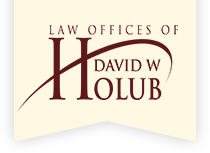Highway Design Is Responsible for My Accident
I’m David Holub, an attorney focusing on personal injury law in northwest Indiana.
Welcome to Personal Injury Primer, where we break down the law into simple terms, provide legal tips, and discuss personal injury law topics.
Today’s question comes from a caller who was in an accident and believes that the highway design played a significant role in causing the crash, and asked about her legal rights to sue the highway designer.
Every once in a while, a motor vehicle crash will end up being the product of a highway design defect.
Highway engineering and design have improved dramatically from what it was 50 years ago.
What do we mean by highway design liability?
For example, highways and streets are designed to uniform traffic control from location to location. For example, a stop sign in Georgia means the same thing as a stop sign in Indiana.
But it’s much more than that. We are talking about uniformity and pavement materials uniformity in markings on the pavement etc. It becomes essential when discussing barricades in channeling devices designed to direct traffic from one lane to another.
Engineers and lawmakers have created what they refer to as Manuals on Uniform Traffic Control Devices. These manuals can run hundreds of pages.
For example, let’s discuss the roundabout intersection.
There are specifications for markings roundabout intersections. As we all know, roundabout intersections are distinctive circular roadways, and they have critical characteristics including:
- A requirement to yield the right-of-way to other vehicles on the circular roadway;
- A deflection of approaching vehicles around the central island; and
- A flare or widening of the approach to the intersection.
Roundabout intersections have to be marked correctly and uniformly.
When drivers encounter them, they must know how to move safely about the roundabout.
Roundabouts become more complicated where crosswalks are added, and more than one lane is going around the circular intersection.
Most of the time, you will find that those involved in constructing these intersections do a great job initially creating the intersection.
In other words, when the intersection first opens to traffic, all of the painted arrows and markings are visible. But what happens when those markings fade?
Without proper pavement markings, the motorist is left to guess how to safely navigate around the intersection.
Leaving motorists to guess at when to yield to other vehicles and under what circumstances rarely leads to safe motoring.
In these complex intersection situations, the liability of the highway department charged with constructing and maintaining the intersection is often a factor.
This example is just the tip of the iceberg.
There are many more situations where highway design becomes critical.
Frequently we must deal with a situation where traffic barriers placed to protect people who might accidentally run off the road are not correctly constructed to absorb impact force and protect the vehicle occupants. The improperly constructed barrier can fail its protective function if it puts a motorist who lost control on ice in the hospital, instead of protecting them from serious injury.
At other times a funneling of traffic down from two lanes to one lane is done without adequately permitting sufficient travel flow to allow for an orderly transition of traffic to the single lane.
In still other cases, we have encountered the extreme danger posed when the timing of traffic signal devices has broken down or become corrupted so that westbound and eastbound traffic has a green light at the same time northbound and southbound traffic has a green light.
Not to be overlooked is the dangers posed by speed humps. When these devices are not carefully marked, or markings degrade, operators can be exposed to extreme danger.
If you’re concerned that signs, pavement markings, barricades, and the like have somehow played a part in a collision, it is best to consult an attorney.
I hope you found this information helpful. If you are a victim of someone’s carelessness, substandard medical care, a product defect, work injury, or another personal injury, please call (219) 736-9700 with your questions. You can also learn more about us by visiting our website at DavidHolubLaw.com – while there, make sure you request a copy of our book “Fighting for Truth.”

Recent Comments